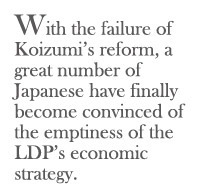Japan’s Coming Election Could Mean Its Withdrawal from the World
Japan’s Coming Election Could Mean Its Withdrawal from the World

EAST STROUDSBURG, PA: Japan is set to elect a new lower house of the parliament on August 30. There is a good chance that the opposition Democratic Party of Japan (DPJ) led by Yukio Hatoyama will beat the Liberal Democratic Party (LDP), which has enjoyed an almost uninterrupted monopoly of government since 1955. If this electoral earthquake happens, it would be, among other reasons, because of Japan’s failure to adjust to globalization. The resulting tremors, too, would be felt far beyond Japan.
Behind this political development lies the Japanese people’s changing perception about their nation’s position in the global economy. The watchers across the world repeatedly warned that Japan, mired in stagnation for the last two decades, will drift into a permanent decline if it failed to undertake fundamental economic reform. Yet, mainstream Japanese opinions did not heed the advice. It was beyond their imagination that the LDP’s economic strategy, which produced prosperity for many years, could be defeated. Further, they had sufficient financial accumulation to endure stagnation for a while. But the current global economic crisis is finally awakening Japan. A great number of Japanese are now persuaded that their economy needs fundamental reform to get out of its slump. This fact underlies the possible end of the LDP’s rule.

A national consensus supporting the economic strategy the LDP has consistently employed since its inception has enabled the party to continue to win elections for a long period. The strategy consisted of two elements. The first is to foster the manufacturing industry by “industrial policy” (i.e., government guidance and incentives) with essentially an export dominated focus. The second leg of the strategy was to distribute the wealth generated by the manufacturing industry evenly across the country. In reality, this meant transferring large sums of money from urban areas, where major manufacturing firms are located, to rural areas. The purpose of this approach was to augment domestic consumption and ensure political stability by preventing the emergence of economic losers.
In the early days, this strategy of leveraging rising global trade delivered admirable results. It quickly turned a war-torn island nation into the second largest economy in the world. By the early 1990s, however, the global expansion of trade and manufacturing made the strategy unsustainable. Japan’s export efforts caused huge trade imbalances and incurred fierce oppositions from the US and Europe. The domestic wage growth and appreciation of the Yen forced Japanese manufacturing companies to move factories overseas. But the electoral importance of rural voters did not change, preventing the LDP from abandoning its commitment to financial support of rural areas. Consequently, the LDP resorted to deficit financing, making Japan experience the worst fiscal deterioration in the industrial world.

It is true that some LDP leaders noticed the crisis of their party’s economic strategy and enacted reform programs to overcome it. However, these programs did not seek to change the strategy’s basic framework and bore only limited fruits. The most important example is the program implemented in 2001-2006 by Prime Minister Junichiro Koizumi, who presented himself as a maverick and vowed to destroy the old LDP. But his plan simply readjusted the balance between the two elements of the LDP’s traditional strategy: giving the manufacturing industry a renewed boost while downsizing financial help to rural areas.
Initially, Koizumi’s reform looked successful. For 2002-2006, the annual GDP growth rate was over 2%, and many analysts praised the reform. Soon, however, its negative aspects became visible, causing great disappointment among the Japanese. The reform swelled economic inequality and undermined Japan’s traditional egalitarianism severely. For example, reduction of financial transfers increased unemployment and poverty in rural areas. Shrinking of welfare expenditures created numerous holes in social safety-nets. Deregulation of labor rules proliferated unstable low-wage jobs at the expense of lifetime employment.

Eventually, the start of the global economic crisis gave a fatal blow to Koizumi’s reform. Although its financial institutions had only limited exposure to risky financial products, Japan is one of the countries worst hit by the crisis. The IMF projects its GDP will fall by 6% this year due to a sharp drop in the export of manufactured goods to the US, which is imposing huge downward-pressures on the Japanese economy. Most importantly, this event revealed that it was not Koizumi’s reform, but the US consumption bubble, that was the cause of Japan’s recent recovery. It has been made clear that despite his thrilling rhetoric, Koizumi operated within the parameters of the LDP’s traditional strategy and never brought about a renaissance.
With the failure of Koizumi’s reform, a great number of Japanese have finally become convinced of the emptiness of the LDP’s economic strategy. This changed popular perception lies behind the head-to-head battle between the DPJ and LDP in the election. Yet, the change of ruling parties will need to be only the first of many steps toward Japan’s revival. Most basically, the Japanese will need to agree on a new economic strategy. At this stage, a DPJ victory means rejection of the LDP, not support for DPJ policy, which is highly ambiguous because it is the amalgamation of diverse platforms.

Thus, once at the helm, the DPJ will have to foster a society-wide discussion to forge a new national consensus on economic strategy. This discussion will have to answer two key questions. First, where can Japan find new growth frontiers? Now that export-led growth is a poor option, Japan will have to turn to domestic markets as its primary source of growth. Second, how can Japan cope with the aging of its population? This question will include reform on pension, employment, and immigration. Further, it will require Japan to find innovative ways to use the emerging markets for the elderly, which range from tourism to medical and care services, as the engine of growth.
How can the possible fall of the LDP’s reign affect the global economy? It is fair to say that in the short term, little impact will be felt at the global level. Immediately after the election, the DPJ’s ambiguous orientation may make the markets nervous. But soon, it will become apparent that lacking concrete ideas about Japan’s renewal and know-how for controlling the powerful bureaucracy, the party will have no choice but to go along with an international economic policy similar to the LDP’s for a while. Unfortunately, this means that Japan will continue to play a secondary role in the global efforts to tackle the current crisis.
However, once Japan gets on a path of recovery, the country will exert large positive influence on the global economy. First, a revived Japan will contribute to the expansion of the global economy through its increased consumption as well as trade and investment. Second, it can provide more leadership in the global efforts to build institutions for economic integration. The LDP’s emphasis on the manufacturing industry led it to a mercantilist approach. Greater attention to the interests of consumers and investors will surely make Japan more committed to the liberal global economic order. Third, as the first full-fledged aged society where there will be only a 2.3 working-age people for every retiree in 2015, Japan will set an important precedent for other countries. If Japan can show compatibility between population aging and prosperity, the world can learn much from it.
Ko Mishima is assistant professor of political science at East Stroudsburg University of Pennsylvania.